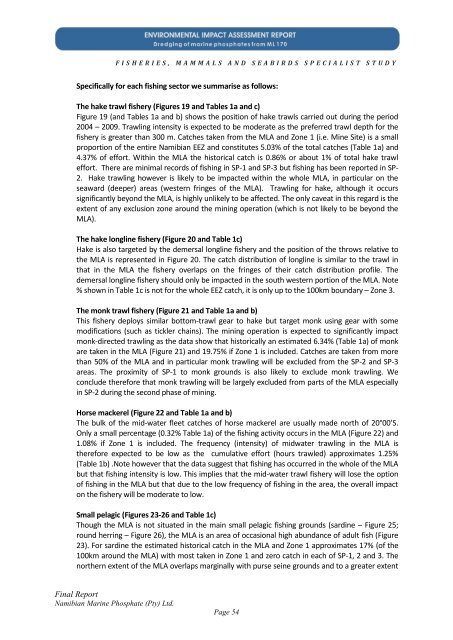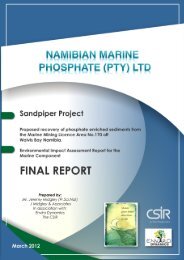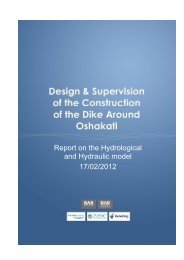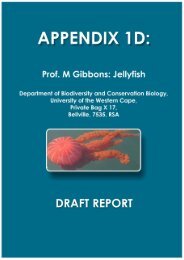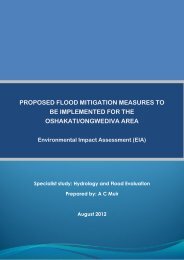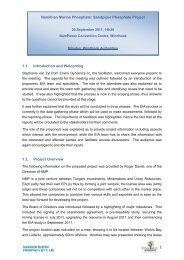Fisheries - Enviro Dynamics Namibia
Fisheries - Enviro Dynamics Namibia
Fisheries - Enviro Dynamics Namibia
You also want an ePaper? Increase the reach of your titles
YUMPU automatically turns print PDFs into web optimized ePapers that Google loves.
F I S H E R I E S , M A M M A L S A N D S E A B I R D S S P E C I A L I S T S T U D Y<br />
Specifically for each fishing sector we summarise as follows:<br />
The hake trawl fishery (Figures 19 and Tables 1a and c)<br />
Figure 19 (and Tables 1a and b) shows the position of hake trawls carried out during the period<br />
2004 – 2009. Trawling intensity is expected to be moderate as the preferred trawl depth for the<br />
fishery is greater than 300 m. Catches taken from the MLA and Zone 1 (i.e. Mine Site) is a small<br />
proportion of the entire <strong>Namibia</strong>n EEZ and constitutes 5.03% of the total catches (Table 1a) and<br />
4.37% of effort. Within the MLA the historical catch is 0.86% or about 1% of total hake trawl<br />
effort. There are minimal records of fishing in SP-1 and SP-3 but fishing has been reported in SP-<br />
2. Hake trawling however is likely to be impacted within the whole MLA, in particular on the<br />
seaward (deeper) areas (western fringes of the MLA). Trawling for hake, although it occurs<br />
significantly beyond the MLA, is highly unlikely to be affected. The only caveat in this regard is the<br />
extent of any exclusion zone around the mining operation (which is not likely to be beyond the<br />
MLA).<br />
The hake longline fishery (Figure 20 and Table 1c)<br />
Hake is also targeted by the demersal longline fishery and the position of the throws relative to<br />
the MLA is represented in Figure 20. The catch distribution of longline is similar to the trawl in<br />
that in the MLA the fishery overlaps on the fringes of their catch distribution profile. The<br />
demersal longline fishery should only be impacted in the south western portion of the MLA. Note<br />
% shown in Table 1c is not for the whole EEZ catch, it is only up to the 100km boundary – Zone 3.<br />
The monk trawl fishery (Figure 21 and Table 1a and b)<br />
This fishery deploys similar bottom-trawl gear to hake but target monk using gear with some<br />
modifications (such as tickler chains). The mining operation is expected to significantly impact<br />
monk-directed trawling as the data show that historically an estimated 6.34% (Table 1a) of monk<br />
are taken in the MLA (Figure 21) and 19.75% if Zone 1 is included. Catches are taken from more<br />
than 50% of the MLA and in particular monk trawling will be excluded from the SP-2 and SP-3<br />
areas. The proximity of SP-1 to monk grounds is also likely to exclude monk trawling. We<br />
conclude therefore that monk trawling will be largely excluded from parts of the MLA especially<br />
in SP-2 during the second phase of mining.<br />
Horse mackerel (Figure 22 and Table 1a and b)<br />
The bulk of the mid-water fleet catches of horse mackerel are usually made north of 20°00’S.<br />
Only a small percentage (0.32% Table 1a) of the fishing activity occurs in the MLA (Figure 22) and<br />
1.08% if Zone 1 is included. The frequency (intensity) of midwater trawling in the MLA is<br />
therefore expected to be low as the cumulative effort (hours trawled) approximates 1.25%<br />
(Table 1b) .Note however that the data suggest that fishing has occurred in the whole of the MLA<br />
but that fishing intensity is low. This implies that the mid-water trawl fishery will lose the option<br />
of fishing in the MLA but that due to the low frequency of fishing in the area, the overall impact<br />
on the fishery will be moderate to low.<br />
Small pelagic (Figures 23-26 and Table 1c)<br />
Though the MLA is not situated in the main small pelagic fishing grounds (sardine – Figure 25;<br />
round herring – Figure 26), the MLA is an area of occasional high abundance of adult fish (Figure<br />
23). For sardine the estimated historical catch in the MLA and Zone 1 approximates 17% (of the<br />
100km around the MLA) with most taken in Zone 1 and zero catch in each of SP-1, 2 and 3. The<br />
northern extent of the MLA overlaps marginally with purse seine grounds and to a greater extent<br />
Final Report<br />
<strong>Namibia</strong>n Marine Phosphate (Pty) Ltd.<br />
Page 54


